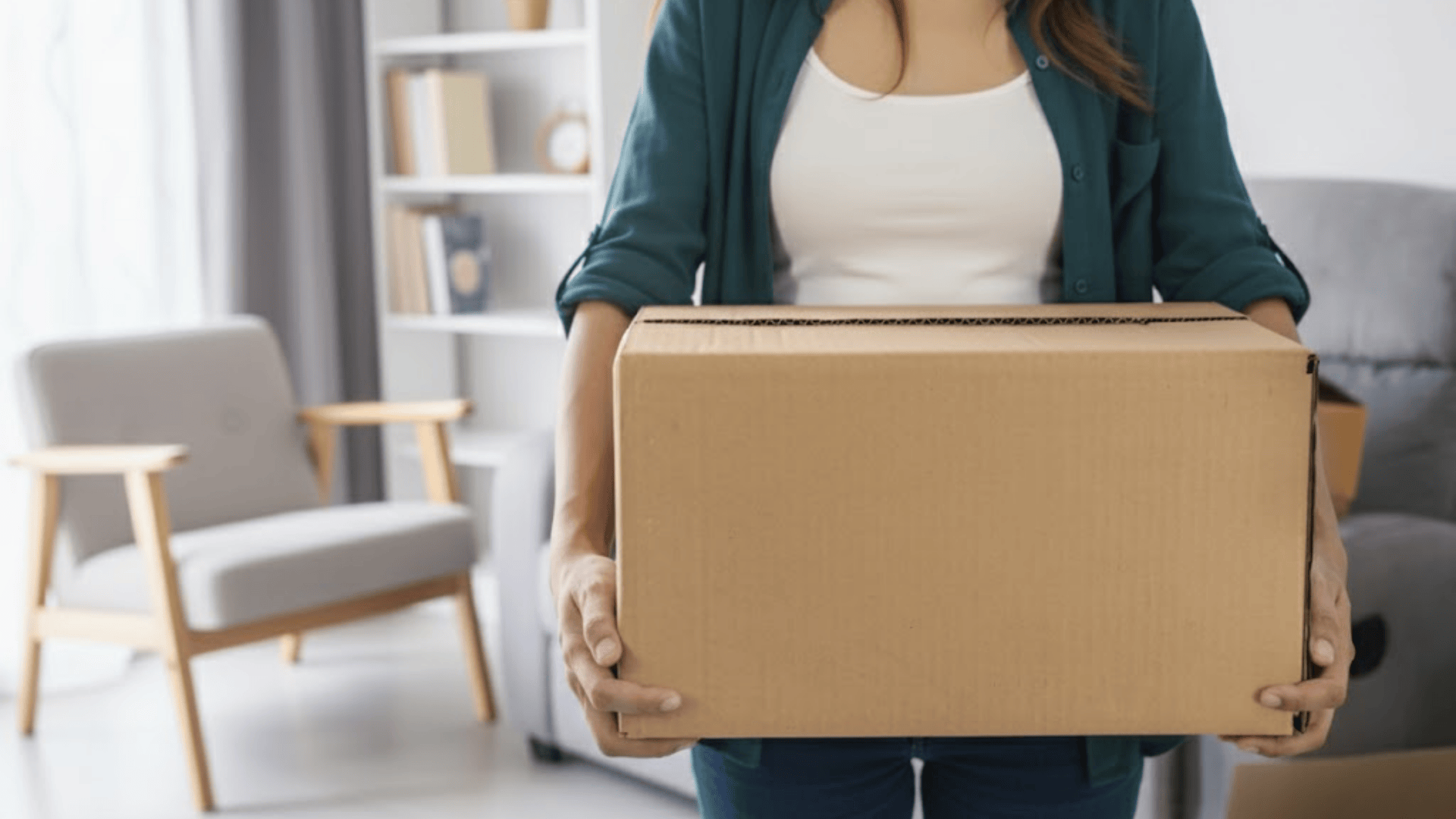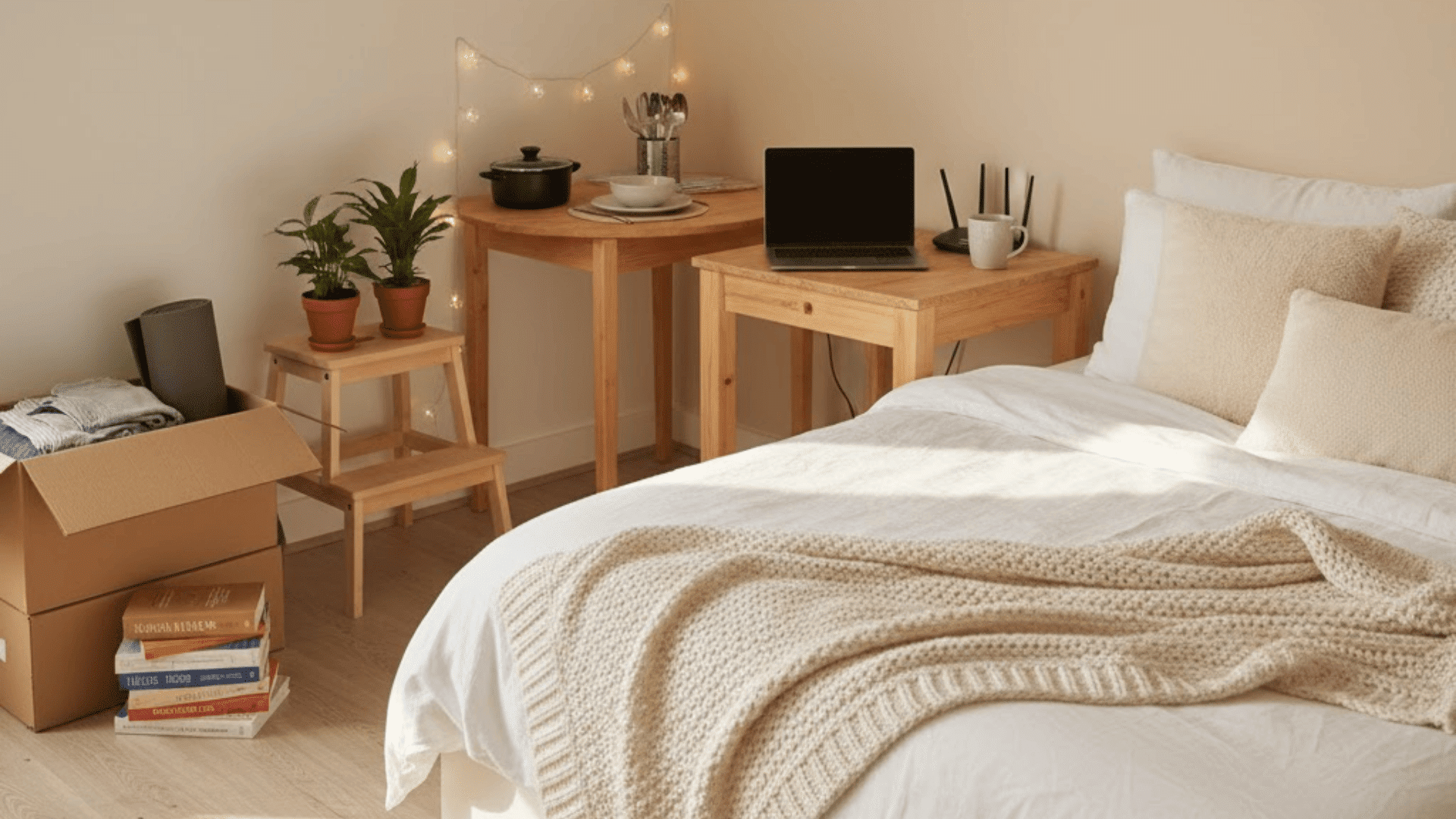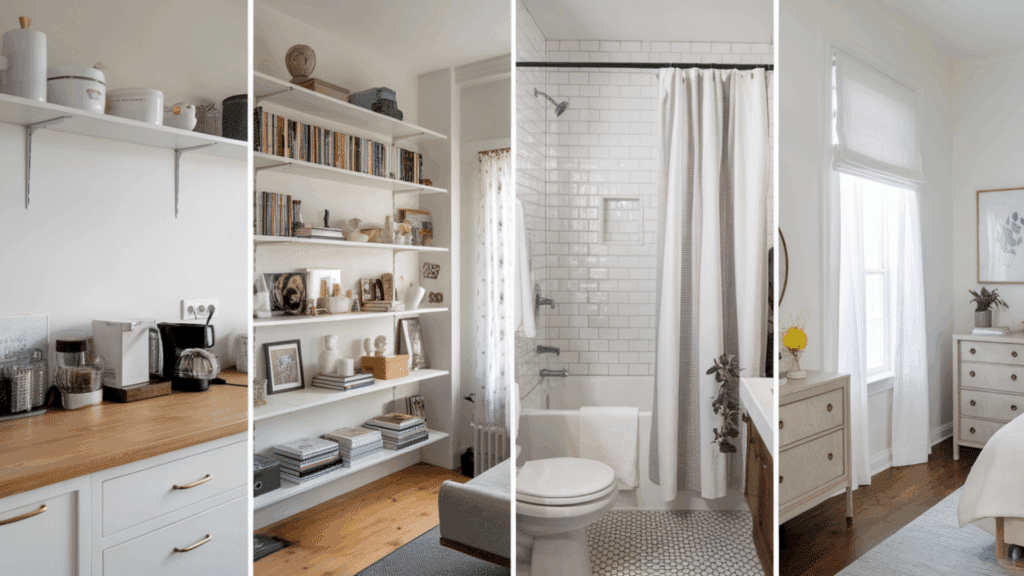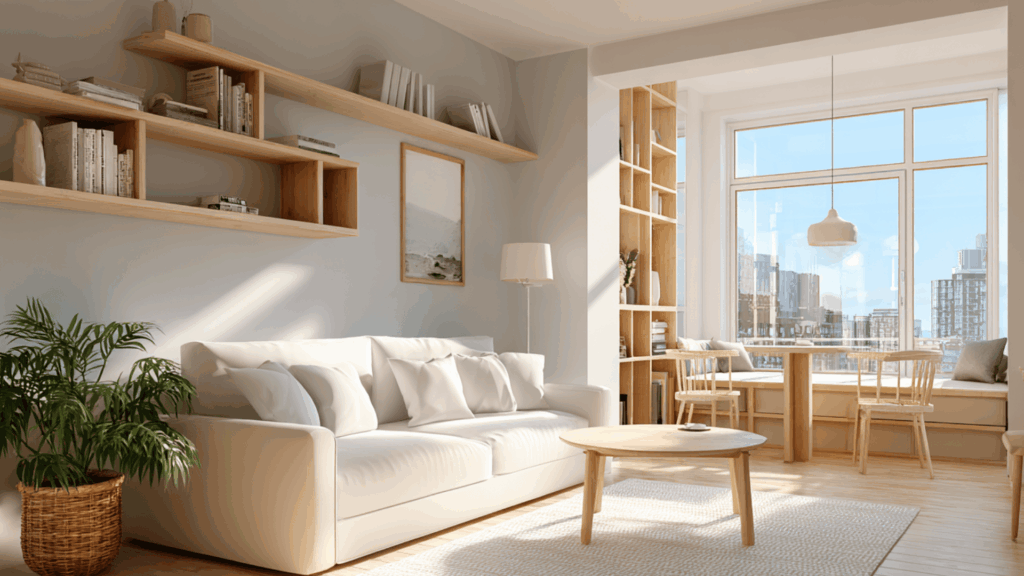Moving for the first time is exciting- and a little scary too. I remember how it felt to pack up, budget every dollar, and figure out what I actually needed.
If you’re standing at that starting line, this guide is for you. You’ll find simple steps to plan your move, stay organized, and save money without the chaos.
From budgeting and packing to settling in and feeling at home, I’ll walk you through what really matters when moving for the first time- so you can start your next chapter with confidence.
How to Plan When Moving for the First Time
Moving for the first time can feel exciting but also overwhelming. A clear plan helps you stay organized, avoid stress, and save both time and money:
- Create a Checklist: Write down everything you need to do, from packing to changing your address.
- Start Early: Begin sorting and packing weeks ahead to avoid last-minute chaos.
- Set a Budget: Include moving supplies, truck rental or movers, and any deposits or fees.
- Label Everything: Mark boxes by room and content to make unpacking easier.
- Keep Essentials Handy: Pack daily-use items like clothes, toiletries, and chargers separately.
Good planning makes your first move smoother and more enjoyable. You’ll settle into your new place with confidence and less stress.
First-Time Moving Made Simple: Key Steps to Follow

Moving out for the first time is a big, exciting change, but it also brings new responsibilities. Having a simple plan makes the process smoother, more affordable, and less stressful.
Step 1: Get Financially Ready
Most moving issues start before packing, so preparing your finances early helps you stay organized.
Save at least two to three months’ rent to cover your deposit and first payment, and plan for truck rental, gas, packing supplies, or mover fees. Don’t forget to include activation costs for water, electricity, or internet.
Create a monthly budget that separates fixed costs like rent and bills from variable ones such as food and transport.
Keep an emergency fund equal to one month’s living expenses, and use a simple budget calculator or worksheet to track your spending and stay within limits.
Step 2: Choose the Right Place to Live
Your space affects comfort, budget, and daily routine. Focus on these essentials:
- Location: Stay close to work, school, or public transport. Check nearby grocery stores, safety, and parking.
- Rent Ratio: Keep rent within 30% of your monthly income.
- Commute: A shorter commute saves time and money.
Before signing, read the rental agreement carefully. Check the lease length, renewal terms, and rules for deposits, repairs, and penalties for ending the lease early.
Step 3: Make a Moving Plan
A clear plan helps you stay organized and avoid last-minute stress. Start early and tackle tasks in small steps. Here’s a simple timeline to follow:
- 3 Months Before: Set your budget, gather supplies, and start decluttering.
- 1 Month Before: Book movers or rent a truck. Notify your landlord and confirm moving dates.
- 2 Weeks Before: Change your address, transfer utilities, and start packing essentials.
- Move-In Week: Clean your new place, check utilities, and unpack your first-night items.
Step 4: Pack Like a Pro
Packing can feel overwhelming, but planning ahead keeps it under control. Start by decluttering to reduce what you need to move, then gather boxes, tape, and wrap early.
Pack an “Essentials Box” with clothes, toiletries, and chargers to keep close during the move. Label boxes by room and contents to make unpacking quicker and stress-free.
Step 5: Moving Day
Moving day can be hectic, but a clear plan keeps things smooth. Confirm details with movers, do a final walkthrough, and clean before leaving to secure your deposit.
Unpack essentials first and tackle one room at a time to stay organized. Remember to eat, hydrate, and take breaks so you finish the day feeling accomplished, not drained.
Step 6: Settling Into Your New Life
The first few days in your new place can feel hectic, so focus on the basics first. Set up utilities, internet, and buy essentials like a bed, cookware, and cleaning supplies.
Decorate slowly – small touches like curtains or a rug go a long way. Track bills, cook simple meals, and connect with friends or neighbors.
Essential First-Time Moving Out and Setup Checklist

Getting your new place ready doesn’t have to be complicated. Focus on what makes your first few days comfortable and your home functional from the start.
First-Night Essentials
Keep these items handy so your first night goes smoothly without rummaging through boxes:
- Bedding: Sheets, pillows, blanket, and comforter.
- Toiletries: Toothbrush, toothpaste, soap, towel, shampoo, deodorant, and toilet paper.
- Snacks and Water: Easy meals, bottled water, instant coffee, and light breakfast items.
- Chargers: For your phone, laptop, and other small devices.
- Medications: Daily prescriptions, pain relievers, and basic first aid (bandages, antiseptics).
- Clothes: One or two outfits, pajamas, and extra socks.
- Lighting: Flashlight or small lamp in case your lights aren’t set up yet.
- Cleaning Basics: Paper towels, wipes, trash bags, and dish soap.
Core Apartment Essentials
Start with what you’ll use every day. Add more as you settle in and figure out what’s missing.
1. Furniture: Bed or mattress, table, chairs, sofa or seating, dresser, and hangers.
2. Kitchen Essentials:
- Cookware: Pots, pans, a baking sheet, and a spatula.
- Dishes: Plates, bowls, glasses, mugs, and cutlery.
- Appliances: Microwave, toaster, electric kettle, or coffee maker.
- Food Storage: Containers, aluminum foil, plastic wrap, and zip bags.
- Cleaning: Sponge, dish soap, drying rack, and towels.
3. Cleaning Supplies:
- Broom, mop, dustpan, and vacuum.
- Trash can and liners.
- Multi-surface cleaner and disinfectant wipes.
- Laundry detergent, basket, and drying rack.
4. Bathroom:
- Shower curtain and hooks.
- Bath mat, towels, and toilet brush.
- Soap, shampoo, and hygiene items.
- A plunger and a small trash can.
5. Bedroom:
- Pillows, a mattress protector, and extra sheets.
- Curtains or blinds for privacy.
- Nightstand and small lamp.
6. Living Area:
- Basic seating (sofa, bean bag, or chairs).
- TV or streaming setup.
- Small shelf or coffee table.
7. Documents: ID, lease papers, bank info, insurance documents, emergency contacts, and spare keys.
8. Tools & Safety:
- Basic toolkit (hammer, screwdriver, tape measure, nails).
- Flashlight and extra batteries.
- Surge protector and extension cords.
- Fire extinguisher and first-aid kit.
Utilities and Setup Essentials
Handle these right away so your home is functional and comfortable from day one:
- Utilities: Set up electricity, water, and gas accounts.
- Internet and Cable: Schedule installation or router setup.
- Safety Checks: Test smoke detectors and carbon monoxide alarms.
- Comfort Setup: Replace air filters, check heating or AC, and set up fans if needed.
- Mail and Address: Change your address with the post office and update banks, employers, and subscriptions.
- Contacts: Save landlord, maintenance, emergency, and nearby repair service numbers.
Extra Comfort and Convenience Items
These aren’t urgent, but make your space more functional and cozy over time:
- Storage: Bins, baskets, hooks, and hangers.
- Workspace: Desk, chair, and good lighting.
- Decor: Plants, rugs, curtains, and wall art.
- Groceries: Salt, pepper, oil, basic spices, rice, pasta, canned goods, and snacks.
- Personal Care: Mirror, hairdryer, grooming kit, and laundry bag.
- Miscellaneous: Batteries, tape, scissors, pen and notepad, and reusable shopping bags.
Moving into your first apartment is easier when you start simple and build up. Get the basics handled first: comfort, safety, and functionality, then personalize the space as you go. With this checklist, you’ll have everything you need to settle in smoothly and feel at home from day one.
Budget-Friendly Moving Strategies
Moving doesn’t have to drain your wallet. A little planning and smart decision-making can help you save big while keeping things stress-free.
- Save on Moving Supplies: Get free boxes from grocery or book stores, or check local online groups. Borrow or rent dollies and pads instead of buying new ones.
- Plan Transportation Wisely: Compare rental trucks, shared movers, or your own vehicle for short moves. Pack fragile items well and consider basic insurance for safety.
- Avoid Hidden Costs: Budget for deposits, cleaning, and utility setup fees. Read your lease for penalties or maintenance charges to prevent surprises.
With a clear plan and mindful spending, you can move efficiently and stay within budget.
Emotional and Practical Readiness
Moving for the first time is both exciting and challenging. Stay calm and organized to handle the change smoothly.
Manage stress by taking breaks, eating well, resting, and asking for help when needed. Build routines for cleaning, paying bills, and meal planning.
Keep a monthly budget and personalize your space with simple touches to feel more at home. Taking care of yourself and staying consistent makes adjusting to independence easier.
Conclusion
Moving for the first time might seem overwhelming, but with the right mindset and plan, it becomes a rewarding experience.
You’ve learned how to budget wisely, stay organized, and handle both the practical and emotional sides of moving.
I know how stressful those first steps can feel, but once you unpack, settle in, and make your new space your own, it all comes together.
Remember – every move is a fresh start, and you’ve got everything it takes to make this one count. So take it slow, stay patient, and enjoy the process of finding your rhythm!





